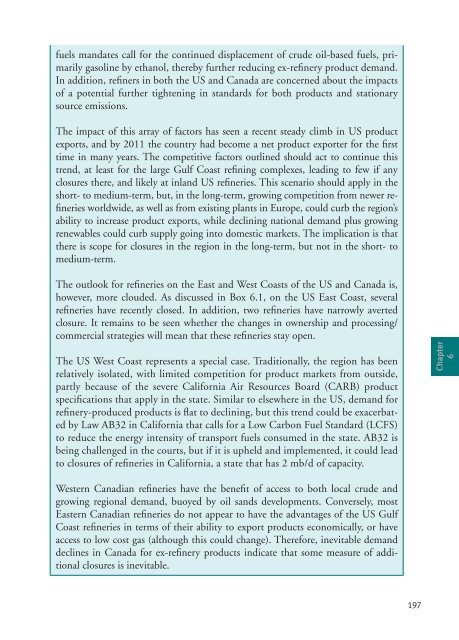World Oil Outlook - Opec
World Oil Outlook - Opec
World Oil Outlook - Opec
- TAGS
- world
- outlook
- opec
- www.opec.org
Create successful ePaper yourself
Turn your PDF publications into a flip-book with our unique Google optimized e-Paper software.
fuels mandates call for the continued displacement of crude oil-based fuels, primarily<br />
gasoline by ethanol, thereby further reducing ex-refinery product demand.<br />
In addition, refiners in both the US and Canada are concerned about the impacts<br />
of a potential further tightening in standards for both products and stationary<br />
source emissions.<br />
The impact of this array of factors has seen a recent steady climb in US product<br />
exports, and by 2011 the country had become a net product exporter for the first<br />
time in many years. The competitive factors outlined should act to continue this<br />
trend, at least for the large Gulf Coast refining complexes, leading to few if any<br />
closures there, and likely at inland US refineries. This scenario should apply in the<br />
short- to medium-term, but, in the long-term, growing competition from newer refineries<br />
worldwide, as well as from existing plants in Europe, could curb the region’s<br />
ability to increase product exports, while declining national demand plus growing<br />
renewables could curb supply going into domestic markets. The implication is that<br />
there is scope for closures in the region in the long-term, but not in the short- to<br />
medium-term.<br />
The outlook for refineries on the East and West Coasts of the US and Canada is,<br />
however, more clouded. As discussed in Box 6.1, on the US East Coast, several<br />
refineries have recently closed. In addition, two refineries have narrowly averted<br />
closure. It remains to be seen whether the changes in ownership and processing/<br />
commercial strategies will mean that these refineries stay open.<br />
The US West Coast represents a special case. Traditionally, the region has been<br />
relatively isolated, with limited competition for product markets from outside,<br />
partly because of the severe California Air Resources Board (CARB) product<br />
specifications that apply in the state. Similar to elsewhere in the US, demand for<br />
refinery-produced products is flat to declining, but this trend could be exacerbated<br />
by Law AB32 in California that calls for a Low Carbon Fuel Standard (LCFS)<br />
to reduce the energy intensity of transport fuels consumed in the state. AB32 is<br />
being challenged in the courts, but if it is upheld and implemented, it could lead<br />
to closures of refineries in California, a state that has 2 mb/d of capacity.<br />
Western Canadian refineries have the benefit of access to both local crude and<br />
growing regional demand, buoyed by oil sands developments. Conversely, most<br />
Eastern Canadian refineries do not appear to have the advantages of the US Gulf<br />
Coast refineries in terms of their ability to export products economically, or have<br />
access to low cost gas (although this could change). Therefore, inevitable demand<br />
declines in Canada for ex-refinery products indicate that some measure of additional<br />
closures is inevitable.<br />
197<br />
Chapter<br />
6
















